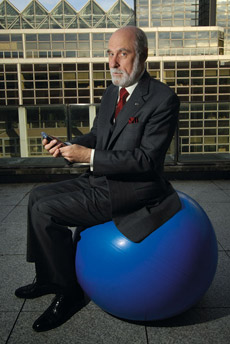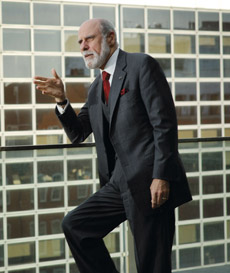Vint Cerf on taking the internet into space
It’s 10 years since his last major interview with .net, and “the father of the internet” is far from retirement. In fact, he’s currently hoping to take the internet beyond the confines of our planet. Oliver Lindberg talks to the one and only Vint Cerf
Vint Cerf naturally flirts with the camera. He jokingly sticks his head through a tree on the roof of Google’s London office and plays with the company’s large, rubber exercise balls, all while wearing one of his trademark three-piece suits. You forget that he’s 64 years old. Cerf joined Google as chief internet evangelist two years ago, and it’s obvious that he enjoys working in such a refreshing environment.
“It’s a very young company,” he says. “I’m sure I increased the average age when I joined, but it’s a rewarding experience. I couldn’t trade this job for anything else. It’s an opportunity to keep learning from really creative and smart people. I’ve actually been pretty astonished. When I think of the energy level of these young people, and their personal backgrounds, the fact that they have been polite is amazing to me. I’m not sure I would be as accommodating to some old geezer who shows up talking about what went on 30 years ago when my problem isn’t 30 years ago, it’s tomorrow morning.”
Father of the internet
Of course, Cerf isn’t just any old geezer. He’s oneof the fathers of the internet, who came up with a way to transmit data over networks for the US military. In fact, he sees the move from his position as a professor at Stanford University to the Defense Department in the early 1970s as one of the biggest challenges in his career. Together with Robert Kahn, he developed the TCP/IP protocols that are part of the basic structure of the internet. “Here I am 34 years later,” Cerf says, “this thing is still exploding and evolving, and we’re far from exhausting all the applications you can invent.”
Sometimes I look at uses to which the net is put and think ‘What a waste of resources’
Unsurprisingly, he has mixed feelings about how the internet developed. “I didn’t anticipate that it would be as big and pervasive as it turned out to be. On the other hand, I can’t feel anything but excitement about how something which started so long ago has captured enough attention to be the scale it is. So many people have been willing to invest in building it, making it bigger and inventing new applications for it. I have to admit, though, that sometimes I look at uses to which the net is put and think ‘What a waste of resources’.”
Vint Cerf mostly uses the internet to deal with emails, look things up on the Google homepage (often using his beloved Blackberry) and, since he’s on the road about 85 per cent of the time, to visit many of the Google engineering offices around the world and consult calendar programs to figure out what he’s doing next. He isn’t bothered about Second Life, Facebook or World of Warcraft. On the contrary, he’s amazed that there are people who have time to spend on these applications.
Reaching for the stars

Being in the company of a man who’s been on the internet for more than three decades is utterly fascinating. Vint Cerf himself has a lot of trouble accepting that he was first introduced to a computer almost 50 years ago: “Half a century! I can’t stand numbers like this!” When he was 15, his father took him to see a tube-based computer. It was part of the Distant Early Warning Line, and received information to see whether any Russian bombers were coming over the pole. “Tube-based computers are so big,” Cerf laughs. “You sit inside the computer you’re using. The walls are lined with tubes and, of course, it’s dark because you’ve got these big radar screens. It was like a scene out of Dr Strangelove. But I was completely captivated by the idea that you could build a thing to do this. Once I was bitten by the computer bug, it was all over. Two years later, my best friend in high school got permission to use the computers at the University of California, Los Angeles, at night and at weekends. He and I would go and program these primitive machines. But one weekend, we showed up and the engineering building was locked and we really, really wanted to get in there and use the machines. There was an open window on the third floor, so my friend helped me scale up.”
Cerf never lost this enthusiasm for technology, and when .net chatted to him 10 years ago (in issue 38), he admitted being a little envious of the opportunities available to young people today. His envy remains unchanged. “I see these eight-year-old kids and they’re teaching their friends how to build web pages,” he sighs. “I’m standing here thinking that I didn’t get to use the internet before I was about 28, and we had to invent it first. We didn’t get to use it at the same age that everybody else did. And I’m not going to live long enough tosee what the eight-year-olds are going to see, about how the net turns out, and I’m really curious. I wish that I could stick my head up in 100 years and see what happens.”
Cerf predicts that he will see a world whereevery appliance is internet-enabled. “Whether it’s a dishwasher, a copying machine, a television set, the air-conditioning system or the water cooler – all these things should be internet-enabled. Once they are, I could control and manage them. I could tell them what to do and ask them questions about what they’re doing – there’s an endless list of things you can do once these devices are accessible. I’m confident that most appliances of any size are going to be internet-enabled. The idea that smart equipment accommodates itself to your needs appeals to me very much.”
Exploring outer space
Cerf’s wildest vision, however, is to take the internet into outer space. He’s been working on the net’s interplanetary extension – which is receiving increasing support from Nasa – with the Jet Propulsion Laboratory since 1998. “If we were going to make the internet run across the solar system, we had to start developing new technologies,” Cerf explains. “My motivation for making an interplanetary internet is the support for manned and robotic exploration of the Solar System. Even though we couldn’t say we were certain that by 2016 we were going to need this rich networking environment for space explorations, we thought that 100 years from now we may have growing, local, domestic planetary internets, and we need to interconnect them somehow. I’m actually pretty excited about the prospect that we can build an ability into the internet to naturally expand across the Solar System. At this point, it’s just engineering: we had good live terrestrial testing and we’re going to begin space-based testing in 2010. We’re hoping tohave at least two or three distinct spacecraft carrying interplanetary internet onboard by 2011. After that, if it’s standardised and accepted, it simply becomes another element of the standard infrastructure of interplanetary exploration.”

The future is clearly very much on Cerf’s mind. Although Google hasn’t got any plans to literally capture the entire internet, he says he’s very interested in at least trying to understand how we preserve our wealth of digital information. “If files that are important persist, how do we make sure that we can still understand what they mean?” he asks. “The only word I can think of to describe it is ‘bitrot’. You keep this big pile of bits and they make sense for a while, and then they rot and no longer make any sense. I’m very concerned about this problem. I don’t want our civilisation to be lost to history because we relied totally on digital storing and processing. More and more content is being created digitally and it can’t be presented in simple text format – it has to be interpreted.” Cerf hopes that we can come up with some standards for the preservation of digital information soon. “It’s just part of being smarter and smarter about crawling around the web,” he adds.
Vint Cerf’s legacy is assured, but even when his time as chairman of ICANN came to an end a few weeks ago, he had no plans to relax. He’s going to spend more time diving deep into the current Google technology. If we were to catch up with Cerf in another 10 years – which we may well do – his list of things that need doing is unlikely to be shorter, but ‘Send the net to another planet’ will probably have a tick beside it. Keep watching this space.

Thank you for reading 5 articles this month* Join now for unlimited access
Enjoy your first month for just £1 / $1 / €1
*Read 5 free articles per month without a subscription

Join now for unlimited access
Try first month for just £1 / $1 / €1
Get the Creative Bloq Newsletter
Daily design news, reviews, how-tos and more, as picked by the editors.

The Creative Bloq team is made up of a group of art and design enthusiasts, and has changed and evolved since Creative Bloq began back in 2012. The current website team consists of eight full-time members of staff: Editor Georgia Coggan, Deputy Editor Rosie Hilder, Ecommerce Editor Beren Neale, Senior News Editor Daniel Piper, Editor, Digital Art and 3D Ian Dean, Tech Reviews Editor Erlingur Einarsson, Ecommerce Writer Beth Nicholls and Staff Writer Natalie Fear, as well as a roster of freelancers from around the world. The ImagineFX magazine team also pitch in, ensuring that content from leading digital art publication ImagineFX is represented on Creative Bloq.
